
Biopharma company Jazz Pharmaceuticals (NASDAQ:JAZZ) fell short of the market’s revenue expectations in Q1 CY2025, with sales flat year on year at $897.8 million. On the other hand, the company’s outlook for the full year was close to analysts’ estimates with revenue guided to $4.28 billion at the midpoint. Its non-GAAP profit of $1.68 per share was 63.9% below analysts’ consensus estimates.
Is now the time to buy Jazz Pharmaceuticals? Find out by accessing our full research report, it’s free.
Jazz Pharmaceuticals (JAZZ) Q1 CY2025 Highlights:
- Revenue: $897.8 million vs analyst estimates of $986.6 million (flat year on year, 9% miss)
- Adjusted EPS: $1.68 vs analyst expectations of $4.66 (63.9% miss)
- The company reconfirmed its revenue guidance for the full year of $4.28 billion at the midpoint
- Management lowered its full-year Adjusted EPS guidance to $4.80 at the midpoint, a 79.4% decrease
- Operating Margin: -6.2%, down from 7.3% in the same quarter last year
- Market Capitalization: $7.18 billion
"In the first quarter of 2025, our focus on commercial execution resulted in total revenues of $898 million, led by the strong performance of Xywav and Epidiolex. In addition, our team continues to receive positive feedback from healthcare providers on the launch of Ziihera® in its first approved indication of 2L HER2+ BTC. We are affirming our 2025 total revenue guidance range of $4.15 - $4.40 billion, reflecting our confidence in our commercial portfolio delivering top-line growth this year," said Bruce Cozadd, chairman and chief executive officer, Jazz Pharmaceuticals.
Company Overview
Originally founded in 2003 and now headquartered in Ireland following a 2012 tax inversion merger, Jazz Pharmaceuticals (NASDAQGS:JAZZ) develops and markets medicines for sleep disorders, epilepsy, and cancer, with a focus on treatments for patients with limited therapeutic options.
Sales Growth
A company’s long-term sales performance is one signal of its overall quality. Even a bad business can shine for one or two quarters, but a top-tier one grows for years. Luckily, Jazz Pharmaceuticals’s sales grew at a solid 13.2% compounded annual growth rate over the last five years. Its growth beat the average healthcare company and shows its offerings resonate with customers.
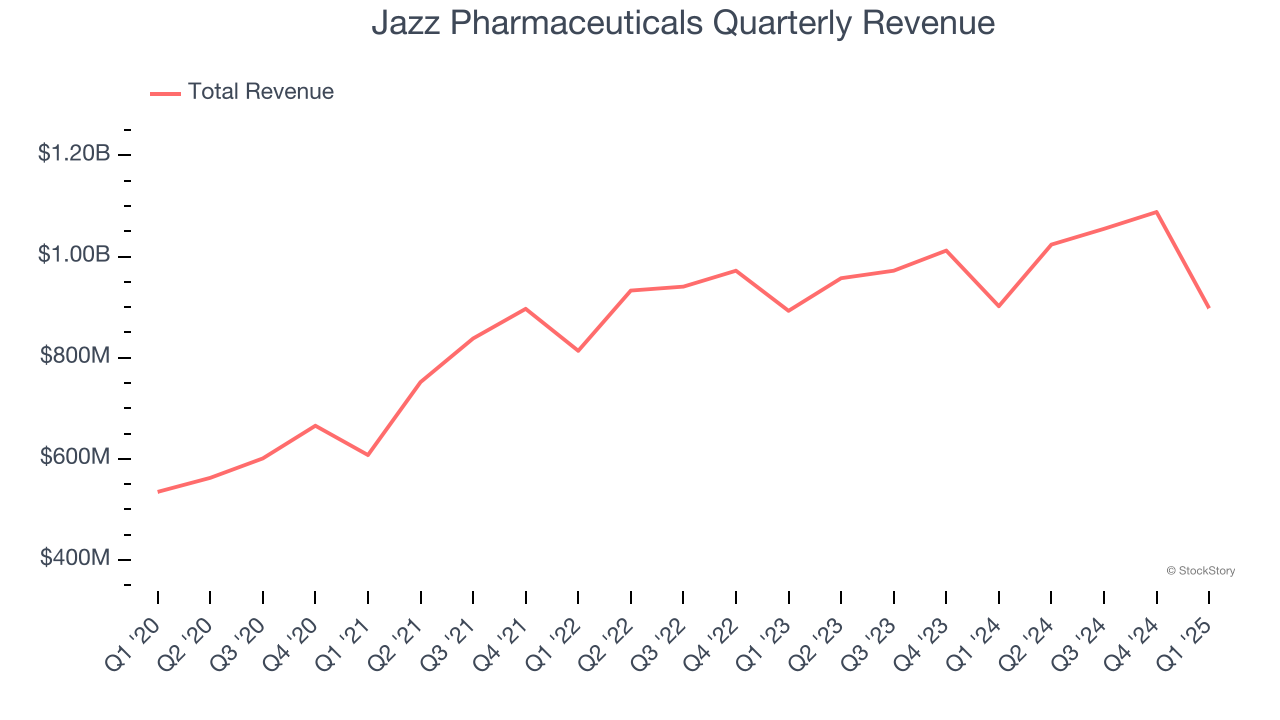
Long-term growth is the most important, but within healthcare, a half-decade historical view may miss new innovations or demand cycles. Jazz Pharmaceuticals’s recent performance shows its demand has slowed as its annualized revenue growth of 4.3% over the last two years was below its five-year trend. 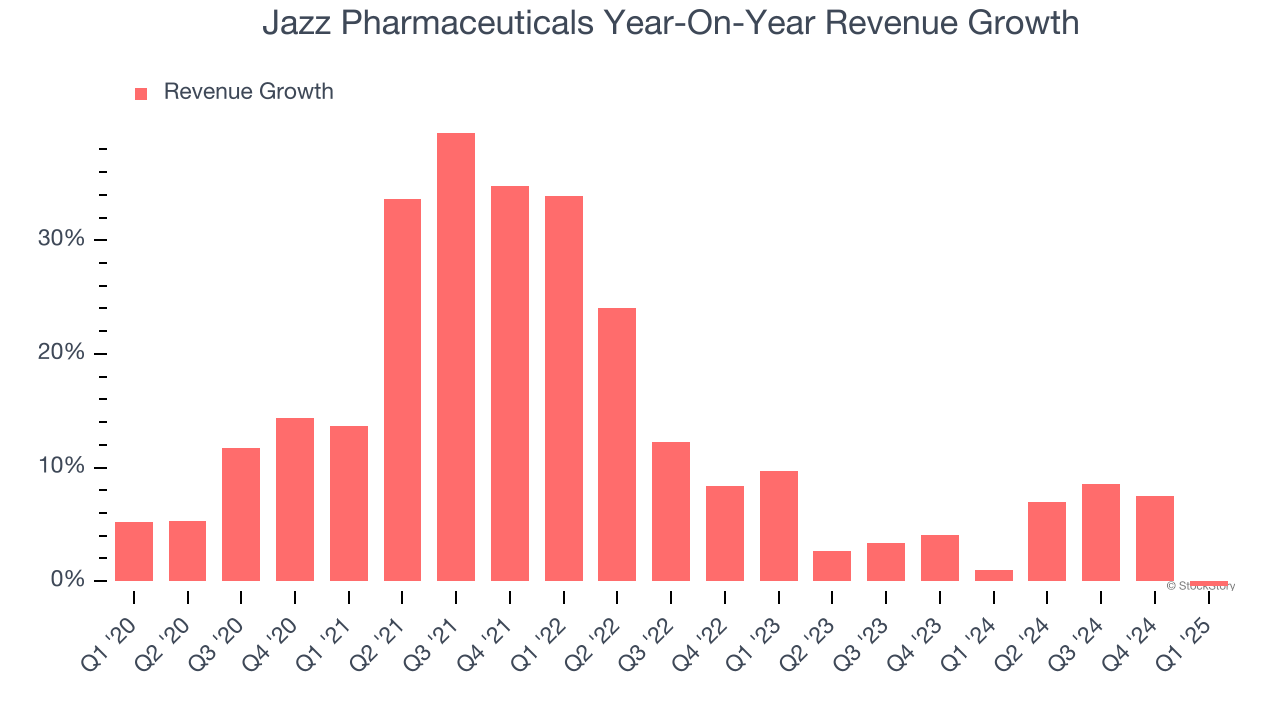
This quarter, Jazz Pharmaceuticals missed Wall Street’s estimates and reported a rather uninspiring 0.5% year-on-year revenue decline, generating $897.8 million of revenue.
Looking ahead, sell-side analysts expect revenue to grow 6.4% over the next 12 months, an improvement versus the last two years. This projection is above average for the sector and implies its newer products and services will spur better top-line performance.
Software is eating the world and there is virtually no industry left that has been untouched by it. That drives increasing demand for tools helping software developers do their jobs, whether it be monitoring critical cloud infrastructure, integrating audio and video functionality, or ensuring smooth content streaming. Click here to access a free report on our 3 favorite stocks to play this generational megatrend.
Operating Margin
Operating margin is an important measure of profitability as it shows the portion of revenue left after accounting for all core expenses – everything from the cost of goods sold to advertising and wages. It’s also useful for comparing profitability across companies with different levels of debt and tax rates because it excludes interest and taxes.
Jazz Pharmaceuticals has done a decent job managing its cost base over the last five years. The company has produced an average operating margin of 11%, higher than the broader healthcare sector.
Analyzing the trend in its profitability, Jazz Pharmaceuticals’s operating margin decreased by 15.3 percentage points over the last five years, but it rose by 15.3 percentage points on a two-year basis. Still, shareholders will want to see Jazz Pharmaceuticals become more profitable in the future.
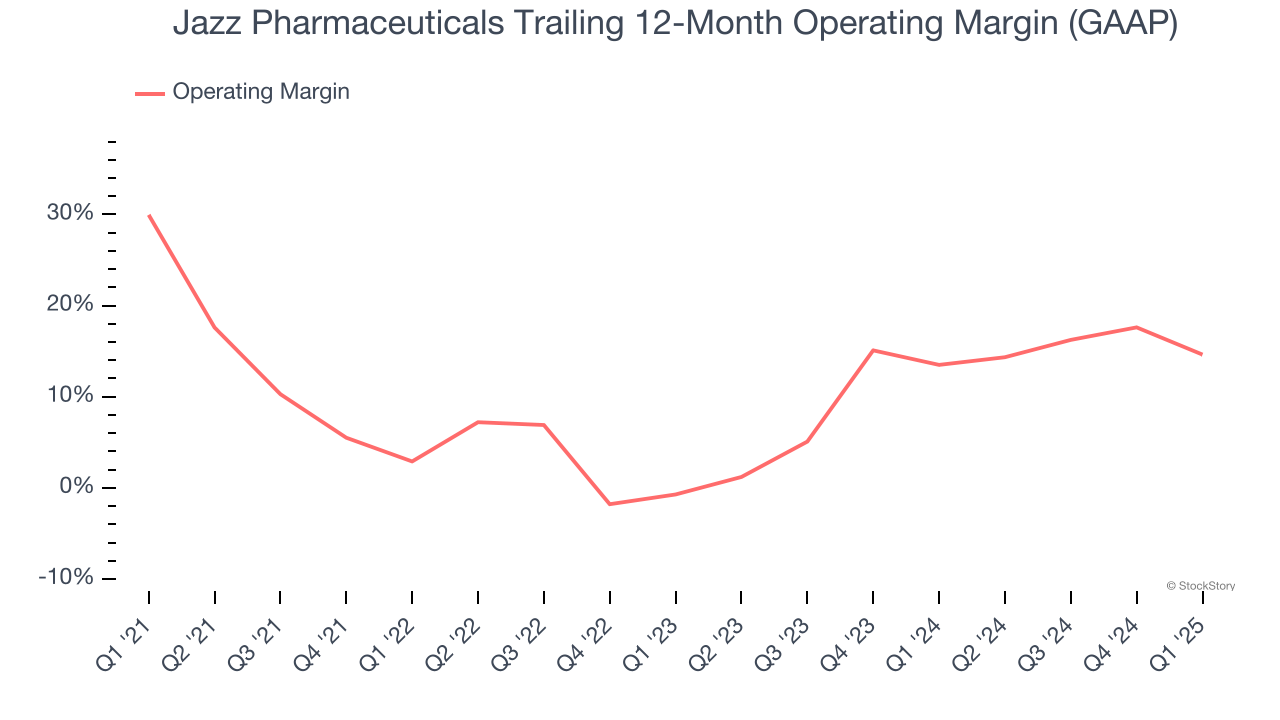
This quarter, Jazz Pharmaceuticals generated an operating profit margin of negative 6.2%, down 13.6 percentage points year on year. This contraction shows it was less efficient because its expenses increased relative to its revenue.
Earnings Per Share
We track the long-term change in earnings per share (EPS) for the same reason as long-term revenue growth. Compared to revenue, however, EPS highlights whether a company’s growth is profitable.
Jazz Pharmaceuticals’s EPS grew at a remarkable 9.2% compounded annual growth rate over the last five years. However, this performance was lower than its 13.2% annualized revenue growth, telling us the company became less profitable on a per-share basis as it expanded.
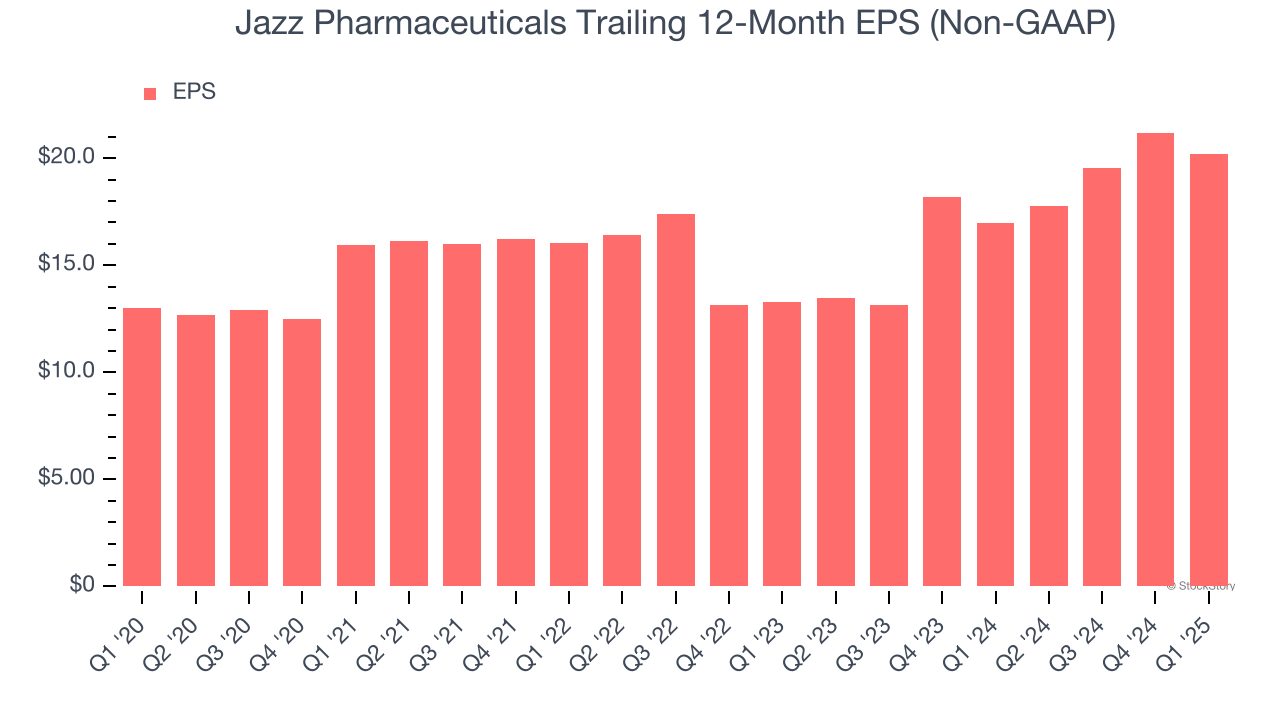
We can take a deeper look into Jazz Pharmaceuticals’s earnings to better understand the drivers of its performance. As we mentioned earlier, Jazz Pharmaceuticals’s operating margin declined by 15.3 percentage points over the last five years. Its share count also grew by 9%, meaning the company not only became less efficient with its operating expenses but also diluted its shareholders. 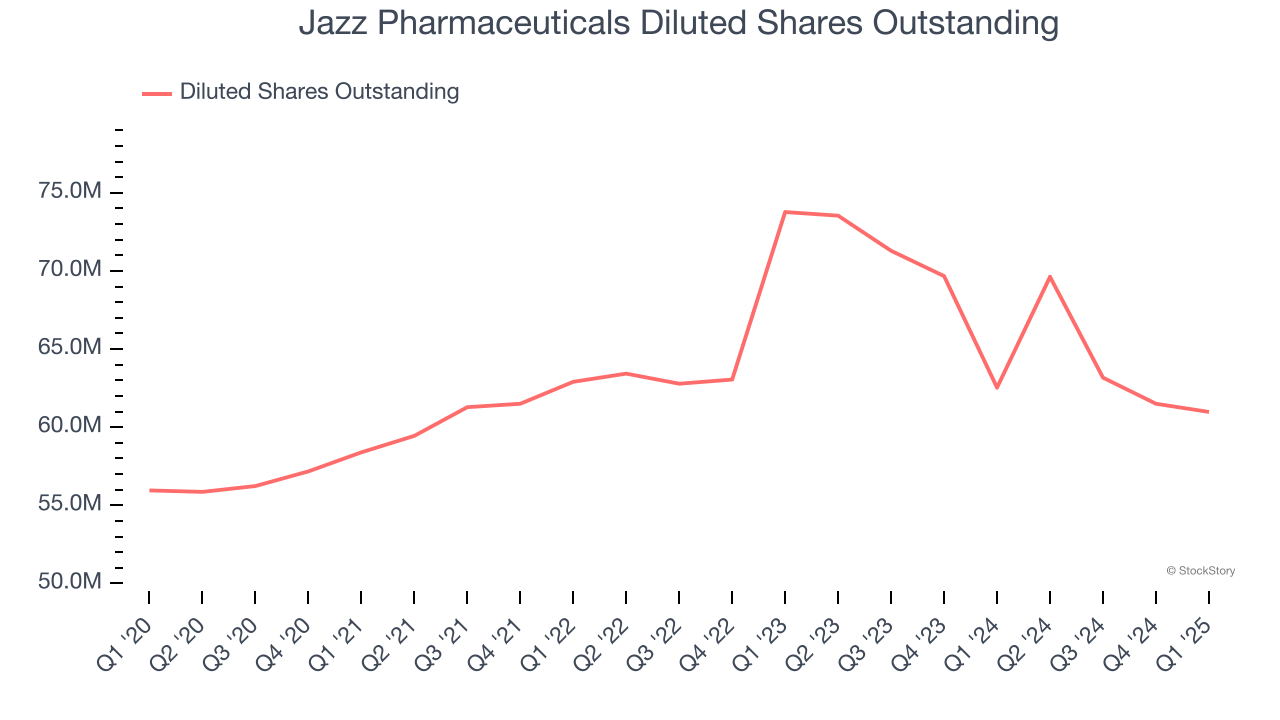
In Q1, Jazz Pharmaceuticals reported EPS at $1.68, down from $2.68 in the same quarter last year. This print missed analysts’ estimates, but we care more about long-term EPS growth than short-term movements. Over the next 12 months, Wall Street expects Jazz Pharmaceuticals’s full-year EPS of $20.19 to grow 15.8%.
Key Takeaways from Jazz Pharmaceuticals’s Q1 Results
We struggled to find many positives in these results as it lowered its full-year EPS guidance and missed on revenue and EPS. Overall, this quarter could have been better. The stock traded down 3.2% to $107.50 immediately following the results.
Jazz Pharmaceuticals didn’t show it’s best hand this quarter, but does that create an opportunity to buy the stock right now? We think that the latest quarter is only one piece of the longer-term business quality puzzle. Quality, when combined with valuation, can help determine if the stock is a buy. We cover that in our actionable full research report which you can read here, it’s free.
